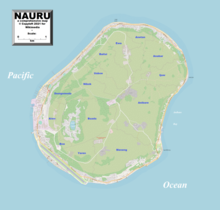Geography of Nauru
Nauruan people |

Its land area is 21 km2 (8.1 sq mi), and it has a 30-kilometre coastline (19 mi). Maritime claims are an
The
A sandy beach rises to the fertile ring around raised
Nauru's only economically significant natural resources are phosphates, formed from guano deposits by seabirds, and fisheries,[2] particularly for tuna.
Due to being surrounded by
.Nauru has a unique navigational system, which is only capable of being used on the island.
Geology of Nauru

Nauru is a
Anibare Bay was formed by the underwater collapse of the east side of the volcano. Buada Lagoon was formed by solution of the limestone when the sea level was lower, followed by collapse.
Nauru is moving at 104 mm (4.1 in) per year to the northwest along with the Pacific Plate.
Freshwater can be found in Buada lagoon, and also in some brackish ponds at the escarpment base in Ijuw and Anabar in the northeast. There is an underground lake in Moqua Cave in the southeast of the island. Since there are no streams or rivers on Nauru, water must be gathered from roof catchment systems. Water is also brought to Nauru as ballast on ships returning for loads of phosphate.[4]
Environmental issues
- Periodic droughts, limited natural freshwater resources (roof storage tanks collect rainwater, but mostly dependent on a single, aging desalination plant)
- Extreme soil conditions are caused by high alkalinity, high phosphate levels, and low potassium. Iron, manganese, copper, molybdenum, and zinc are rendered unavailable to plants. Combined with thin or damaged soils this causes low fertility.
- Intensive phosphate miningduring the past 90 years has left the central 80% of Nauru a wasteland and threatens limited remaining land resources.
Nauru is a party to the international environmental agreements on
Climate
Nauru's climate is hot and very humid year-round because of its proximity to the equator and the ocean. Nauru is hit by monsoon rains between November and February, but rarely has cyclones. Annual rainfall is highly variable and is influenced by the El Niño–Southern Oscillation, with several significant recorded droughts.[5][6] The temperature on Nauru ranges between 30 and 35 °C (86 and 95 °F) during the day and is quite stable at around 25 °C (77 °F) at night.[7]
| Climate data for Yaren District, Nauru | |||||||||||||
|---|---|---|---|---|---|---|---|---|---|---|---|---|---|
| Month | Jan | Feb | Mar | Apr | May | Jun | Jul | Aug | Sep | Oct | Nov | Dec | Year |
| Record high °C (°F) | 34 (93) |
37 (99) |
35 (95) |
35 (95) |
32 (90) |
32 (90) |
35 (95) |
33 (91) |
35 (95) |
34 (93) |
36 (97) |
35 (95) |
37 (99) |
| Mean daily maximum °C (°F) | 30 (86) |
30 (86) |
30 (86) |
30 (86) |
30 (86) |
30 (86) |
30 (86) |
30 (86) |
30 (86) |
31 (88) |
31 (88) |
31 (88) |
30 (87) |
| Mean daily minimum °C (°F) | 25 (77) |
25 (77) |
25 (77) |
25 (77) |
25 (77) |
25 (77) |
25 (77) |
25 (77) |
25 (77) |
25 (77) |
25 (77) |
25 (77) |
25 (77) |
| Record low °C (°F) | 21 (70) |
21 (70) |
21 (70) |
21 (70) |
20 (68) |
21 (70) |
20 (68) |
21 (70) |
20 (68) |
21 (70) |
21 (70) |
21 (70) |
20 (68) |
| Average precipitation mm (inches) | 280 (11.0) |
250 (9.8) |
190 (7.5) |
190 (7.5) |
120 (4.7) |
110 (4.3) |
150 (5.9) |
130 (5.1) |
120 (4.7) |
100 (3.9) |
120 (4.7) |
280 (11.0) |
2,080 (81.9) |
| Average precipitation days | 16 | 14 | 13 | 11 | 9 | 9 | 12 | 14 | 11 | 10 | 13 | 15 | 152 |
| Source: Weatherbase | |||||||||||||
Extreme points
This is a list of the extreme points of Nauru, the points that are farther north, south, east or west or higher than any other location.
- Northernmost point – Cape Anna, Ewa District.
- Easternmost point – Cape Ijuw, Ijuw District.
- Southernmost point – unnamed headland south of the wireless station, Meneng District.
- Westernmost point – the harbour, Aiwo District.
- Highest point – Command Ridge (65 m, 213 ft).
- Lowest point – Pacific Ocean (sea level).
References
- ^ CIA factbook. "Nauru Terrain - Geography". www.indexmundi.com. Retrieved 19 April 2016.
- ^ Annual Report Part 1: Information on Fisheries, Research and Statistics: Republic of Nauru. Archived 2020-07-03 at the Wayback Machine Working Paper 17 of the 4th Scientific Committee of the Western and Central Pacific Fisheries Commission. WCPFC 2008.
- ^ Republic of Nauru. 1999. Climate Change Response Under the United Nations Framework Convention on Climate Change URL Accessed 2006-05-03
- ^ "Yaren | district, Nauru". Encyclopedia Britannica. Retrieved 2019-09-02.
- ^ Nauru Department of Economic Development and Environment (2003). "First National Report to the United Nations Convention to Combat Desertification" (PDF). United Nations. Archived from the original (PDF) on 22 July 2011. Retrieved 25 June 2012.
- ISBN 978-92-1-070936-1.
- ^ "Pacific Climate Change Science Program" (PDF). Government of Australia. Archived from the original (PDF) on 27 February 2012. Retrieved 10 June 2012.
